By R.K. Campbell | Contributing Editor
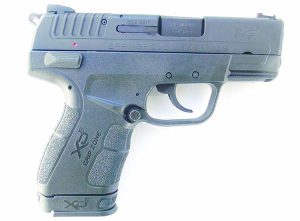
The Springfield Armory XDE has a unique appearance.
I enjoy my conversations with Darrel, John, Clay and David at South Carolina Gun Company. You cannot learn unless you are around knowledgeable individuals. The conversation turned, recently, to the new Springfield XDE 9mm and ended with the author taking an example home, the first in the shop.
The Springfield XDE is a development of the XD series and features a steel slide over a polymer frame. After this the resemblance fades. The XDE is a double action first shot pistol with a manual safety and a decocker lever. The XDE is larger than the XDS because it takes more room to accommodate the more complicated DA trigger, but that isn’t a drawback with the proper concealment gear such as the Galco Stow and Go holster. At only 23 ounces, 6.75 inches overall and with a 3.3 inch barrel, this is a compact handgun. The E in XDE stands for external hammer. There are many advantages to the exposed hammer. As one example some of us like the comfort of riding the thumb on the hammer as we holster. If the hammer moves, then something has snagged the trigger. We may tell at a glance if the handgun is cocked or if it is safe with the hammer down. The pistol has good features including capable combat sights and an ergonomic grip that offers good abrasion and adhesion but not at the expense of being raspy.
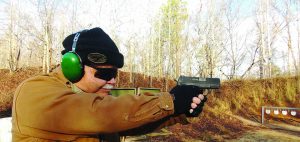
The morning was brisk for a field test session but the XDE pistol was very pleasant
The pistol is compact at only an inch wide. The grip features a good hand fit for most of us and houses a nine-round magazine. The pistol is supplied with three magazines. Two are nine round magazines. One is an eight round magazine with a finger stub. A small flat base plate is supplied with the pistol. I think the nine round magazine is good but if you need to pare down the size of the handle the flat base might be an advantage. In handling the larger base makes for better hand fit for most of us.
The XDE features a double-action first shot trigger. This means a long trigger press both cocks and drops the hammer. After the pistol fires the slide recoils and cocks the hammer for subsequent single-action shots. The trigger does one thing, drops the hammer in single action fire. Since it isn’t the safest move to try to control the hammer with the thumb and lower it by pressing the trigger, the XDE features a decocker lever. Press this lever down and the hammer is safely dropped. Never manually lower the hammer. It is less sure and also may not properly set the firing pin block.
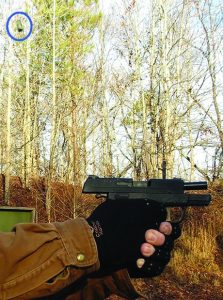
A case is in the air as the pistol locks open—and the sights are still on target.
The pistol features a manual safety. The handgun may be carried hammer down and safety on or hammer to the rear and safety on. Most of us will carry the pistol hammer down. Another plus is that the piece may be loaded with the safety on. You may even disassemble the piece with the safety on, and you need not pull the trigger before disassembly. This action is what is called a selective double action. The safety does not lock the slide when applied. The long double action press is a safety feature, and if you carry with the safety applied then be certain to practice rapid manipulation of the safety. After the first shot is fired and you are engaged in tactical movement you may apply the safety. Snap the safety off and you have a crisp single action shot. This eliminates the need to decock the pistol during tactical movement after the first shot is fired.
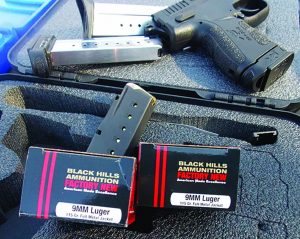
Black Hills Ammunition gave excellent results.
I like the new grip design of the XDE. I found the XDS .45 downright uncomfortable; by contrast the XDE has abrasion in the right place but enough smooth surface to allow rapidly adjusting the hand if need be. There is no grip safety. The XD is a single action, the XDE a double-action first shot pistol so there is no need for the grip safety. There are grooves in each side of the frame that allow for a shorter trigger reach. The double action trigger breaks at perhaps 14 pounds. The single action press is 6.5 pounds. There is a bit of take-up in the single action press. The safety and magazine release are ambidextrous. The slide lock is not. The pistol takes down easily with a rotating lever. There is a short light rail that works with most combat lights. The slide is well machined with no tool marks. The slide is angular flat and thin. The cocking serrations offer a good purchase. The sights are good examples of combat sights with a bright fiber optic front sight and two white dots in the rear sight. There are extra fiber optic inserts included, one red and one green.
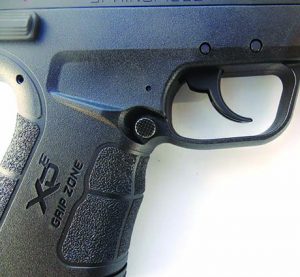
Grip treatment is ideal for adhesion when firing. The magazine release is ambidextrous.
When all is said and done, the pistol appeals to those that prefer the handling of the double-action first shot handgun over the striker fired handgun. The XDE is of polymer construction, however, and that allows the pistol to be produced affordably. Another feature Springfield points out is the LES (low effort slide) feature. By cocking the hammer and racking the slide to load there is less force needed. This is important to those with less hand strength.
As I write this I have over 500 rounds invested in the XDE and I have learned something about the pistol. I was initially concerned that the decocker might be activated during recoil with the thumb riding on the safety, but this hasn’t occurred. The decocker lever features a strong spring. I have learned the hard way that even the most expensive handguns are not always feed reliable. The pistol has digested quite a diverse lot of loads from the major makers and hasn’t offered a hiccup. At this point I thought it good to evaluate the piece with some of my favorite personal defense and practice loads. This was the final exam so to speak.
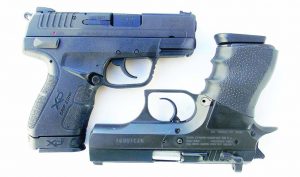
The XDE, left, compares well to traditional handguns such as the Baby Desert Eagle.
I loaded the magazines with Black Hills Ammunition 115-grain FMJ loads. I drew quickly from a Galco Stow and Go holster and began the test at 7 yards, firing the first shot double action and following with two more rounds, de-cocking the action, then following twice more. Results were good. When I dropped the magazine the generous magazine well allowed a fast reload. Even though the pistol is supplied with three magazines I wanted another during the test program! I moved to ten yards and hammered the X ring out in single-action fire with another three magazines. This dog will run and it is as comfortable to fire as most much heavier 9mm handguns. I also fired at targets at known and unknown distances, connecting more often than not. The sights are well regulated for 115 to 124-grain bullet weights.
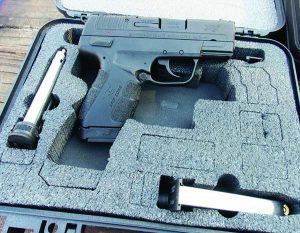
The XDE is supplied with three magazines—a clear advantage.
In 9mm defense ammunition the field is broad and the selection process should reflect your needs. The Black Hills Ammunition 124-grain JHP breaks about 1060 fps from this 3.3 inch barrel. This load is easily controlled and features a balance of expansion and penetration favoring penetration. Practical accuracy is good. A faster load at 1170 fps is the Black Hills Ammunition EXP or Extra Power load. This 115-grain JHP offers rapid expansion without moving into +P pressure. Both are credible loads, with the 124-grain JHP preferred for those that may be facing felons bundled behind heavy clothing. Quality control is excellent in either. Both loads exhibited a full powder burn and excellent accuracy potential. As for accuracy, I tested the pistol over the benchrest, firing from Brownell’s Bullshooters pistol rest. The best effort at 15 yards was 2.4 inches with the Black Hills Ammunition 124-grain JHP. Clearly the pistol is accurate enough for defense use.
The Springfield XDE is long on features that many Americans like to see on their personal defense handguns. A manual safety, an exposed hammer and good sights are good to have. The pistol is reliable and accurate enough for personal defense. The price is fair. Springfield has a winner in the XDE 9mm.



